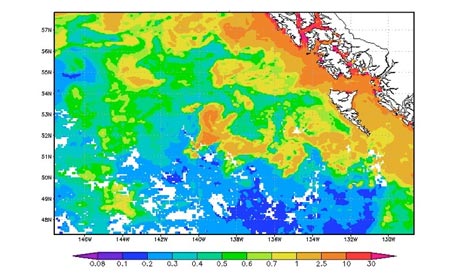A controversial American businessman dumped around 100 tonnes of iron sulphate into the Pacific Ocean as part of a geoengineering scheme off the west coast of Canada in July, a Guardian investigation can reveal.
Lawyers, environmentalists and civil society groups are calling it a "blatant violation" of two international moratoria and the news is likely to spark outrage at a United Nations environmental summit taking place in India this week.
Satellite images appear to confirm the claim by Californian Russ George that the iron has spawned an artificial plankton bloom as large as 10,000 square kilometres. The intention is for the plankton to absorb carbon dioxide and then sink to the ocean bed – a geoengineering technique known as ocean fertilisation that he hopes will net lucrative carbon credits.
George is the former chief executive of Planktos Inc, whose previous failed efforts to conduct large-scale commercial dumps near the Galapagos and Canary Islands led to his vessels being barred from ports by the Spanish and Ecuadorean governments. The US Environmental Protection Agency warned him that flying a US flag for his Galapagos project would violate US laws, and his activities are credited in part to the passing of international moratoria at the United Nations limiting ocean fertilisation experiments
Scientists are debating whether iron fertilisation can lock carbon into the deep ocean over the long term, and have raised concerns that it can irreparably harm ocean ecosystems, produce toxic tides and lifeless waters, and worsen ocean acidification and global warming.
"It is difficult if not impossible to detect and describe important effects that we know might occur months or years later," said John Cullen , an oceanographer at Dalhousie University. "Some possible effects, such as deep-water oxygen depletion and alteration of distant food webs, should rule out ocean manipulation. History is full of examples of ecological manipulations that backfired."
George says his team of unidentified scientists has been monitoring the results of the biggest ever geoengineering experiment with equipment loaned from US agencies like Nasa and the National Ocean and Atmospheric Administration. He told the Guardian that it is the "most substantial ocean restoration project in history," and has collected a "greater density and depth of scientific data than ever before".
"We've gathered data targeting all the possible fears that have been raised [about ocean fertilisation]," George said. "And the news is good news, all around, for the planet."
The dump took place from a fishing boat in an eddy 200 nautical miles west of the islands of Haida Gwaii, one of the world's most celebrated, diverse ecosystems, where George convinced the local council of an indigenous village to establish the Haida Salmon Restoration Corporation to channel more than $1m of its own funds into the project.
The president of the Haida nation, Guujaaw, said the village was told the dump would environmentally benefit the ocean, which is crucial to their livelihood and culture.
"The village people voted to support what they were told was a 'salmon enhancement project' and would not have agreed if they had been told of any potential negative effects or that it was in breach of an international convention," Guujaaw said.
International legal experts say George's project has contravened the UN's convention on biological diversity (CBD) and London convention on the dumping of wastes at sea, which both prohibit for-profit ocean fertilisation activities.
"It appears to be a blatant violation of two international resolutions," said Kristina M Gjerde, a senior high seas adviser for the International Union for Conservation of Nature. "Even the placement of iron particles into the ocean, whether for carbon sequestration or fish replenishment, should not take place, unless it is assessed and found to be legitimate scientific research without commercial motivation. This does not appear to even have had the guise of legitimate scientific research."
George told the Guardian that the two moratoria are a "mythology" and do not apply to his project.
The parties to the UN CBD are currently meeting in Hyderabad, India, where the governments of Bolivia, the Philippines and African nations as well as indigenous peoples organizations are calling for the current moratorium to be upgraded to a comprehensive test ban of geoengineering that includes enforcement mechanisms.
"If rogue geoengineer Russ George really has misled this indigenous community, and dumped iron into their waters, we hope to see swift legal response to his behavior and strong action taken to the heights of the Canadian and US governments," said Silvia Ribeiro of the international technology watchdog ETC Group, which first discovered the existence of the scheme. "It is now more urgent than ever that governments unequivocally ban such open-air geoengineering experiments. They are a dangerous distraction providing governments and industry with an excuse to avoid reducing fossil fuel emissions."

